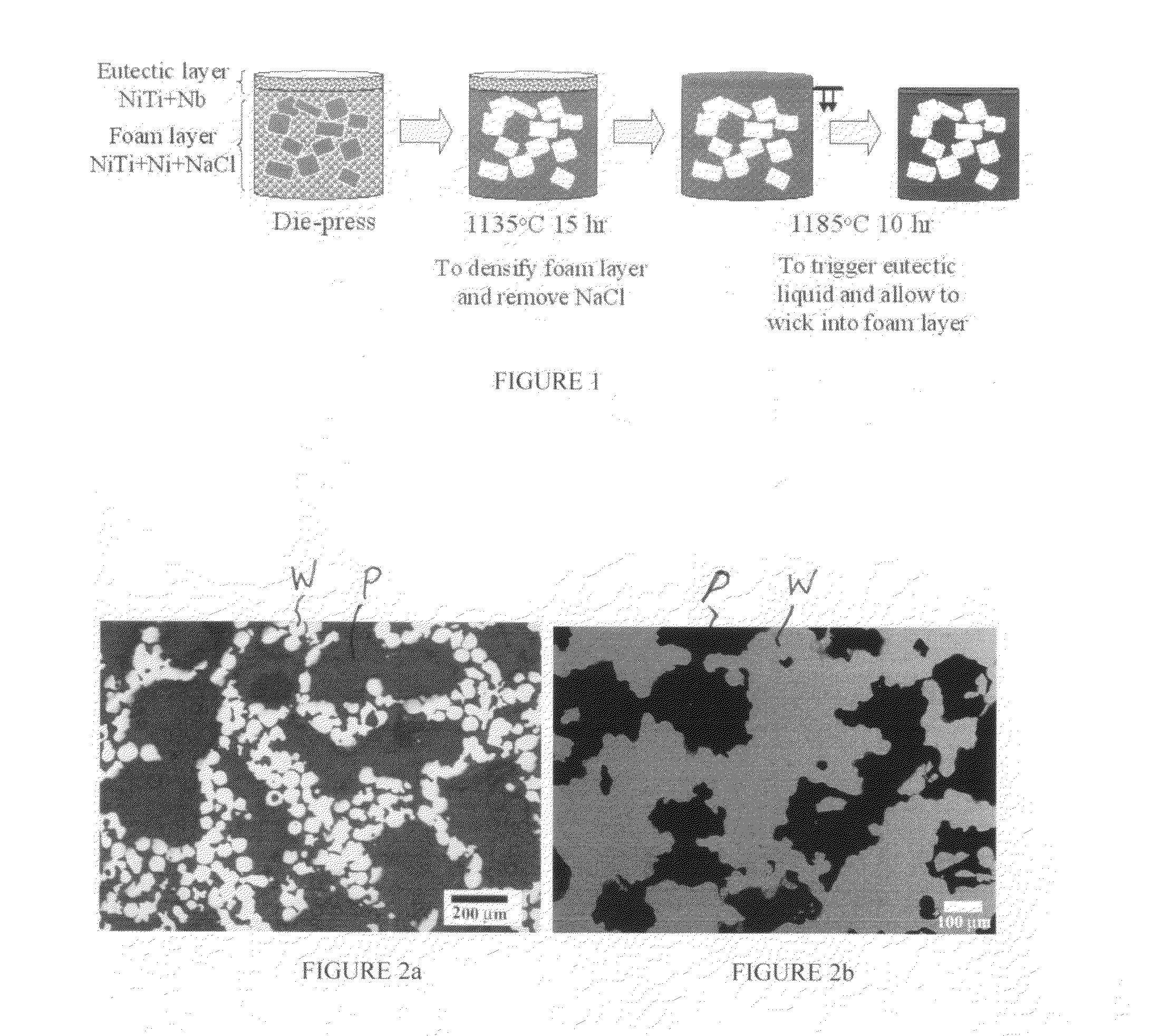Method of making metallic foams and foams produced
a technology of foam and metallic foam, which is applied in the field of metal foam, can solve the problems of inability to offer a tailor-made porous structure, inability to manufacture niti foams with high melting point (1310° c.) by liquid phase processes, and inability to achieve tailor-made porous structures, etc., to achieve the effect of reducing microporosity and maintaining the desired macroporosity of niti foam
- Summary
- Abstract
- Description
- Claims
- Application Information
AI Technical Summary
Benefits of technology
Problems solved by technology
Method used
Image
Examples
example 1
[0032]This Example is offered to illustrate a so-called double-layer method embodiment of the invention that comprises (i) mixing pre-alloyed NiTi powders (with or without Ni addition) and inert space-holder powders (such as a salt) as a first layer region of a compact; (ii) mixing a transient (eutectic) liquid phase sintering agent with the pre-alloyed NiTi powders as a second layer region, which is then pressed on top of the first layer region to provide a single compact; (iii) sintering under vacuum this single compact at a temperature below the eutectic temperature to partially sinter NiTi powders into a skeleton structure while the space-holder powders are removed by evaporation, leaving desired macro-porosity in the NiTi foam skeleton structure which also contains undesirable microporosity; (iv) heating the compact at a higher second temperature above the eutectic temperature to create a transient liquid eutectic phase which wicks into the microporosity of the previously forme...
example 2
[0057]This Example is offered to illustrate fabrication of NiTi foam using NaCl powder particles as spaceholder particles (pore forming agent) and Nb powder particles as densification enhancer (eutectic liquid forming agent) using a controlled heating rate to achieve solid state sintering followed by a hold at a transient liquid phase sintering stage.
[0058]In this Example, shape-memory NiTi foams were produced by sintering of a NiTi—Nb—NaCl powder mixture pellet at 1185° C. for 10 hours with a heating rate of 7° C. / min and then furnace cooled to room temperature. Prealloyed NiTi, Nb and NaCl powders used in the mixture were from the same batch and the sintering process was conducted in the same high vacuum furnace as in Example 1 with Nb powders having a particle size of 1-5 μm. The ratio of NiTi to NaCl was 3 to 2 by volume and the Nb addition was about 5.3 wt %. Unlike Example 1, all powders were mixed together without separating into double layers since Ni, reactive with Nb, was ...
example 3
[0062]This Example is offered to illustrate fabrication of NiTi foam by using Nb chopped (discontinuous) wire lengths as both spaceholder particles (pore forming agent) and densification enhancer (eutectic liquid forming agent) using a controlled heating rate to achieve solid state sintering followed by a hold at a transient liquid phase sintering stage.
[0063]In particular, Nb chopped wires of 0.125 mm diameter and 0.5-1 mm long were mixed with prealloyed NiTi powder in the ratio of 5.3 wt. % Nb to 94.7 at. % NiTi. The powder / chopped wire mixture was die pressed with a pressure of 350 MPa into 12.7-mm diameter and 8 mm-tall pellet. The pellet was sintered in a high vacuum furnace at 1185° C. for 10 hours with a heating rate of 7° C. / min and then furnace cooled to room temperature. The resulting microstructure of the NiTi foam (FIG. 5) reveals porosity of 30% with macropores with 250-500 μm size and some micropores with 5-10 μm size. Macropores were produced by the disappearance of N...
PUM
| Property | Measurement | Unit |
|---|---|---|
| Particle size | aaaaa | aaaaa |
| Porosity | aaaaa | aaaaa |
| Temperature | aaaaa | aaaaa |
Abstract
Description
Claims
Application Information
 Login to View More
Login to View More - R&D
- Intellectual Property
- Life Sciences
- Materials
- Tech Scout
- Unparalleled Data Quality
- Higher Quality Content
- 60% Fewer Hallucinations
Browse by: Latest US Patents, China's latest patents, Technical Efficacy Thesaurus, Application Domain, Technology Topic, Popular Technical Reports.
© 2025 PatSnap. All rights reserved.Legal|Privacy policy|Modern Slavery Act Transparency Statement|Sitemap|About US| Contact US: help@patsnap.com



